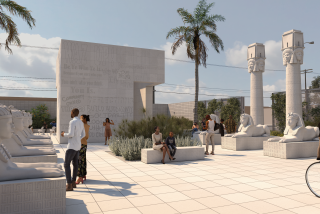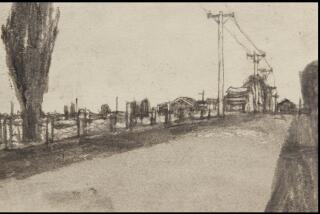New York sues for return of Central Park drawings
- Share via
Reporting from New York — Central Park is almost synonymous with New York. But historians have long wondered whether the city’s signature park was originally conceived the way it looks today. Were the ornate colorful tiles underneath the Bethesda Terrace a vision of the original designers? What about elegant black lamps that dot the park?
Now historians might finally have some clues about the park’s design.
Illustrations for features of Central Park and other public places in New York have resurfaced, and the city has gone to court to get them back. Real estate broker Sam Buckley said his father found the drawings, by Jacob Wrey Mould, in a Manhattan trash bin sometime before 1960, according to court documents.
Though Calvert Vaux and Frederick Law Olmsted designed Central Park, Mould assisted with several noteworthy landmarks of the public space, such as Bethesda Terrace and Belvedere Castle.
The 127 drawings, which date from 1860 to 1885, are stamped “Department of Public Parks.” The city claims it never authorized the destruction or abandonment of the drawings and believes they were “lost or erroneously discarded.”
The city learned about the drawings after Buckley placed 86 of them for sale with Christie’s auction house. He kept the remaining 41. The city asked the court to award $1 million in damages or compel Buckley to hand over the illustrations.
Christie’s and Buckley have agreed not to sell the works while the settlement talks play out. The auction house declined to comment, and Buckley could not be reached.
The 86 drawings being held at Christie’s include illustrations for a wide variety of items and venues — a drinking fountain for horses, lamps, clocks, approaches to the American Museum of Natural History and music pavilions for various city parks, including Washington Square and Tompkins Square. All were prepared by Mould, or under his direction, the city says.
Mould, born in Britain, was known for importing the flair of British Victorian architecture to his U.S. work. He moved to New York in 1853, and also designed several churches in the area. He was the park department’s chief architect for three years.
Through their designs, Mould and Vaux wanted to lift the eye out of the landscape of Central Park and onto the Belvedere Castle. Mould thought of the Bethesda Terrace — known for its showcase angel fountain and seen in movies such as “Annie Hall” and “The Replacements” — as a social space, said Elizabeth Blackmar, a professor of history at Columbia University.
Blackmar said illustrations of historical structures should be in the public domain.
“I think having those things in public archives available to researchers is vitally important,” she said. “It’s part of a public heritage.”
Gerald Singleton, the city’s lawyer, said he expected a quick resolution to the case. “It should work out,” he said.
It’s unclear how and when the drawings were lost or discarded. Buckley told Christie’s officials he inherited them from his father, who had discovered them in a Manhattan garbage container.
The drawings might help historians learn more about how Central Park was planned and how it evolved, said Sara Cedar Miller, the historian and photographer for the Central Park Conservancy, which works in conjunction with the city to maintain the park.
“They are important clues as to how they were thinking of designing the park,” she said.
nicole.santacruz@latimes.com
More to Read
The biggest entertainment stories
Get our big stories about Hollywood, film, television, music, arts, culture and more right in your inbox as soon as they publish.
You may occasionally receive promotional content from the Los Angeles Times.











